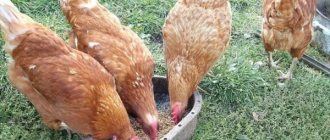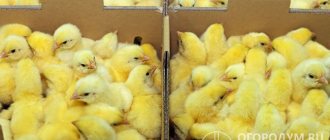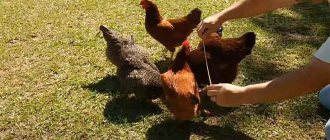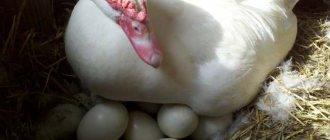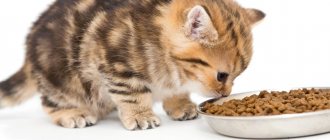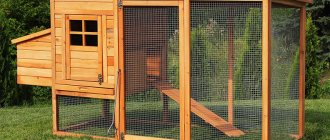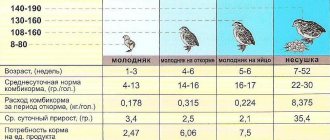The effect of overfeeding and underfeeding on the health of chickens
For successful raising of laying hens at home, feeding plays a primary role.
There are two main rules:
- Overfeeding of poultry should not be allowed . There is a common misconception among inexperienced farmers - they believe that the more food a chicken consumes, the higher its productivity becomes. However, unbalanced diet in large quantities contributes to obesity. And it directly leads to a decrease in egg production.
- Poultry should not be underfed. Lack of food and vital vitamins and minerals leads to the following negative consequences:
- small eggs;
- thin shell or no shell at all;
- poor quality of eggs;
- decreased egg production;
- risks of diseases in poultry.
It is bad to go from one extreme to the other. The chicken should receive balanced feed in the required dosage for good health and high productivity.
Vitamin supplements
For full development and increased egg production, chickens need vitamins, which are not always enough in feed.
"Felucene" for chickens
“Felucene” contains the entire complex of vitamins and minerals.
Find out more about how to use Felucene for chickens.
They start giving it to chickens at one and a half months of age. For laying hens, 7 g of the substance is added to the total volume of feed. When using the supplement, exclude salt, chalk, and premixes from the diet.
Is it possible to feed chickens yeast?
Feed yeast helps increase egg production. They are administered taking into account live weight - 30 g/kg. Yeast is added to the feed, poured with warm water and left for 8-10 hours. During all this time, the food is mixed three times.
Read more
Is it possible to feed chickens yeast?
The disadvantage of the supplement is the appearance of ailments in the bird, which are expressed in the form of diseases:
- diarrhea;
- stagnation of fluid in the body (which leads to inflammation of the cloaca);
- cannibalism;
- disorders in the development of joints.
To reduce the risk of side effects, calcium supplements (for example, meat and bone meal or eggshells) are added to the feed along with the yeast. Feed yeast is contraindicated for poultry that has not reached a weight of 1 kg.
Egg shells
Before giving eggshells to birds, they are fried in the oven and then ground into powder. Disinfected shells can be added to wet mashes or poured into separate containers placed throughout the walking area and in the chicken coop.
Fish fat
The dosage of fish oil is strictly regulated. The supplement is given in weekly courses with a break of 10 days.
For young chickens one and a half months old, fish oil is added to the feeder at the rate of 0.2 ml per head; for adult chickens, the dosage is increased to 0.5 ml per head. A month before slaughter, the additive is completely excluded from the diet.
Did you know? In addition to the food additive, there is technical fish oil used for technical purposes in leather production, dyeing, and soap making.
Is it possible to give chickens polystyrene foam, and why do they peck at it?
Polystyrene foam is a building material, and that is its only purpose. If chickens eat polystyrene foam, their meat and egg products become toxic and unfit for human consumption.
Find out more
Is it possible to give chickens polystyrene foam and why do they peck at it? The material is not digested by the stomach and is poorly excreted from the body, causing the appearance of compactions in the crop, which leads to suffocation.
Reasons for chickens eating foam:
- curiosity - the bright crunchy material is similar in structure to grain, so the bird tries to taste it;
- lack of salt - the foam contains sodium chloride;
- “drug” addiction - polystyrene foam releases a toxic substance pentane into the air, which when inhaled has a narcotic effect.
What to feed laying hens
Domestic laying hens are not picky in terms of the type of feeding. They calmly eat weeds from the garden, food scraps from the table, and leftover feed from other pets. However, this does not have the best effect on the productivity of egg laying.
Internal reserves contribute to the formation of eggs, but this exhausts the bird. It is important to organize a balanced menu, then the chickens will be healthy, and therefore the yield of eggs will increase.
There are 3 types of chicken feed on the farm:
- dry;
- wet;
- combined.
Also, natural plant diversity – weeds and cultivated herbs – cannot be excluded.
Compound feed
Compound feed refers to dry food, which one laying hen should consume 110–130 grams daily. It is produced and sold already crushed to the required level so that the bird can easily digest it without overeating.
Wet food
Wet food is created at home. It is prepared from the liquid part (dairy products or water) and a mixture of boiled potato roots, chopped green grass, meal, various seasonal vegetables, wheat bran, various cereals and cake.
It is prepared in small portions so that the chickens eat it right away and it does not remain sour.
Grain mixtures
Farmers at home feed laying hens with a combination of dry and wet feed.
For convenience, ready-made dry feed mixtures are used. They occupy up to 75% of the daily diet of poultry. The fact is that even the best composition cannot meet all the body’s needs for protein, calcium and phosphorus.
Base of grain mixture:
- corn up to 50%;
- oats up to 15%;
- wheat up to 70%.
Laying hens can easily digest and assimilate most grains. For them, it is a valuable source of vitamins, fiber and carbohydrates.
Green food
Regardless of where laying hens are kept, they need greens. It is one of the main resources for replenishing vitamins, moisture and fiber. When free-grazing, they independently choose and eat the herbs they need.
For individuals kept in cages or pens, it is necessary to provide a daily portion of green food, this directly affects their egg production.
Chickens accept lettuce, dill, alfalfa, clover, young leaves of legumes, stinging nettle and other plants that do not irritate the gastrointestinal tract well.
In the winter months, laying hens replace fresh greens with hay and coniferous tree needles. The food also includes raw, shelf-stable vegetables - turnips, pumpkin, squash, carrots, zucchini and potatoes.
What food is needed to increase egg production?
In addition to the combination of wet and dry food, the menu should contain vitamin and mineral supplements. Sunflowers, legumes and flax increase egg production.
A particularly important trace element for poultry is calcium. To replenish it, the menu includes chalk, fish or meat and bone meal, shells and limestone.
Norms of daily feed consumption
Raising chickens that lay eggs will be successful if you follow two important rules:
- Overfeeding of poultry is prohibited . Many people new to poultry farming think that the more a chicken eats, the more eggs it will lay. It's a delusion. If a chicken overeats, obesity occurs, leading to a decrease in egg production. Egg yield also decreases if the bird receives food that is unbalanced in fats, proteins and carbohydrates.
- Underfeeding of poultry is prohibited . Lack of nutrition immediately affects the quality of eggs. Underfed chickens lay small eggs with thin shells, or even without them at all. Malnutrition affects productivity, and then the well-being and health of the bird.
Nutritional standards for adult chicken
Laying hens raised in households receive a diet that differs significantly from the menu on large poultry farms. Backyard chickens have access to natural products, so their eggs are healthier and more nutritious.
Every year the laying hen consumes:
- mixed feed - approximately 40 kg;
- greens – 15 kg.
The annual consumption rate is calculated on a daily basis. On a day, an adult laying hen should receive:
- feed – 120-160 g;
- including greens - 40-50 g.
Daily caloric content of an adult chicken:
- free-range – 300-320 kcal;
- when kept in a cage – 260-280 kcal.
Food should have the following balance:
- protein – 15-20%;
- fats – 3-5%;
- carbohydrates – 70-75%;
- fiber – 5-6%.
In winter, food standards are increased by 15-20%, since it is necessary to replenish the energy that the bird spends on maintaining heat.
Why does chicken need so many carbohydrates? She needs energy for:
- egg formation;
- movement - chickens are active and move around the yard and chicken coop a lot.
There are breeds that easily tolerate frosts without reducing egg production - they need more feed. Others do not leave the chicken coop, preferring warmth, then feeding standards, on the contrary, are reduced.
Egg formation occurs at night, so chickens should be fed more densely in the evening, especially in the winter season.
The chicken should receive a drink - about 300 ml of water per day.
Necessary components in the diet of chickens
Balanced and properly organized feeding of laying hens is the key to stable and productive egg production. For these purposes, compound feed is divided into narrowly targeted categories:
- vitamins;
- protein;
- carbohydrates;
- mineral;
- sand and gravel content.
Required nutritional value of feed for laying hens per day:
| Components | Content in % |
| Cellulose | 5–6 |
| Carbohydrates | 55–70 |
| Fats | 3–5 |
| Squirrels | 18–20 |
Most of the incoming protein and fat are spent on the formation of eggs. Carbohydrates are used for energy to support the life of the bird.
The table below shows the percentage ratio of products from the feed composition for the proper nutrition of laying hens:
| Feed | Content in % |
| Cereals | 65 |
| Products of natural origin | 6 |
| Table salt | 1 |
| Bran | 8 |
| Yeast | 5 |
| Mineral supplements | 9 |
| Herbal flour | 7 |
Depending on the time of year, the main elements in food are needed in larger or smaller quantities.
Ways to increase egg production of chickens
The productivity of laying hens is influenced by the following factors:
- chicken health;
- lighting in the chicken coop;
- bird breed;
- air temperature in the poultry house;
- age of the laying hen;
- nutrition.
To increase the number of eggs you need to follow these tips:
- Meals should be constant and in equal portions.
- The chicken's first feeding should occur early in the morning immediately after she wakes up.
- It is necessary to avoid undernutrition and overfeeding of laying hens.
- The second feeding should be done an hour before bedtime.
- The chicken's diet should be varied and contain many vitamins and minerals.
- A strict balance between proteins, carbohydrates, vitamins and fats is necessary.
- It is recommended to maximize the nutrient content in chicken feed in the spring. This is necessary to obtain a healthy offspring.
- The diet of laying hens must contain whole grains, corn, barley, wheat and oats.
- Chickens should be provided with 17 hours of daylight.
- Organizing a comfortable environment: the air in the poultry house should be dry and warm.
Ready-made feed - industrial mixture
The diet of laying hens in households and farms contains factory-made compound feed. It is already balanced and divided in composition for representatives of different ages and purposes.
Main types:
- Concentrated feed (CC). It contains ground and compressed grain in the form of small granules, premix p-2 or p-1. This food has a protein deficiency of only about 12%. Therefore, when feeding chickens, it must be combined with food additives - meal, animal protein, cake, etc.
- Complete feed (PC). The recommended composition meets all quality requirements for feeding laying hens. One drawback is the relatively high cost.
| Type of feed | Compound | Purpose |
| PC 1 (Divided into PC 1–1, PC 1–2, PC 1–3) | Corn grains | Feed hens from 20 to 45 weeks. |
| Wheat grains | ||
| Barley grains | ||
| Gluten from corn | ||
| Fish meal | ||
| Bone flour | ||
| Sunflower meal | ||
| Soybean meal | ||
| Table salt | ||
| Defluorinated phosphates | ||
| Limestone flour | ||
| PC 2 | Feed methionine | Feed chicks 1–7 weeks old |
| Corn grains | ||
| Wheat grains | ||
| Table salt | ||
| Lysine | ||
| Fish meal | ||
| Sunflower cake | ||
| Limestone flour | ||
| Soybean meal | ||
| P5–1 premix | ||
| PC 3 | Baker's yeast | Feed young animals 8–20 weeks of age |
| Wheat grains | ||
| Sunflower oil | ||
| Sunflower meal | ||
| Lysine | ||
| Bone flour | ||
| Baking soda | ||
| P2 premix | ||
| Soybean meal | ||
| Elements of Tricalcium Phosphate | ||
| Limestone flour | ||
| Feed methionine |
PC 1 contents and properties
Feeding laying hens with PC 1 compound feed should begin from the moment they begin to lay eggs. It is intended specifically for egg breeds.
A high-quality, balanced composition allows you to achieve maximum productivity without resorting to various food impurities.
| Compound | Content percentage |
| Wheat | 62,5 |
| Meat and bone meal | 4 |
| Feed yeast | 2,5 |
| Table salt | 0,101 |
| Sunflower oil | 2,3 |
| Tricalcium phosphate | 1,95 |
| Limestone flour | 7,5 |
| Sunflower meal | 17,5 |
| Lysine | 0,301 |
| Feed methionine | 0,1 |
| Threonine | 0,118 |
| Baking soda | 0,07 |
| Premix P1-2 | 1 |
| Choline chloride B4 | 0,06 |
PC 2 contents and properties
Compound feed is intended to feed young animals aged from 7 to 50 days. The consistency is like fine grains. It promotes long-term saturation, healthy growth and development of the body.
| Compound | Content percentage |
| Wheat | 43,7 |
| Soybean meal | 11,15 |
| Corn | 30,41 |
| Sunflower cake | 8 |
| Monocalcium phosphate | 1,33 |
| Lysine | 0,45 |
| Feed methionine | 0,2 |
| P5-1 premix | 1 |
| Fish meal | 1,8 |
| Table salt | 0,24 |
PC 3 contents and properties
Balanced composition to feed laying hens from 8 to 20 weeks. The food is aimed at preparing the body for the start of egg production.
| Compound | Content percentage |
| Wheat | 73,5 |
| Lysine | 0,31 |
| P2 premix | 1 |
| Feed methionine | 0,16 |
| Sunflower oil | 8 |
| Soybean meal | 5,5 |
| Bone flour | 2 |
| Table salt | 0,25 |
| Sunflower meal | 13 |
| Baker's yeast | 1 |
| Elements of Tricalcium Phosphate | 2 |
| Baking soda | 0,1 |
| Limestone flour | 0,38 |
PC 1–1 contents and properties
This feed for laying hens covers almost all nutritional needs. The quality and quantity of eggs improves.
| Compound | Content percentage |
| Corn | 9 |
| Wheat | 50 |
| Bone flour | 4,7 |
| Table salt | 0,3 |
| Barley | 10 |
| Corn gluten | 1 |
| Sunflower meal | 13 |
| Fish meal | 1 |
| Soybean meal | 5 |
| Defluorinated phosphates | 1 |
| Limestone flour | 2 |
PC 1–3 contents and properties
Designed to feed egg-laying chickens from 45 weeks of life. The consistency is presented in the form of small granules. In this form, it promotes faster saturation.
| Compound | Content percentage |
| Wheat bran | 12 |
| Wheat | 14,1 |
| Barley | 30 |
| Table salt | 0,3 |
| Premixes | 1 |
| Chalk | 3 |
| Oats | 15 |
| Sunflower meal | 8,1 |
| 3/feed wheat prize | 2 |
| Limestone flour | 1,5 |
How do nutritional standards depend on the age of the chicken?
We have already looked at how to feed chickens in the first months of life. Next, nutrition will change as the chicken grows older:
- The period from the 2nd to the 4th month of life. During these months, bones are quickly formed, weight increases, and future productive qualities are being laid. Calorie content is reduced to 260 kcal per 100 g of feed. Protein is given at 15%, and the fiber rate increases to 5%, and remains this way until the end of the chicken’s life. The bird must also receive enough microelements from the feed - the dosage is the same throughout the life of the chicken.
- The period from the 4th to the 5th month of life. The stage of formation of egg production is completed. Laying hens are given food with a calorie content of 270 kcal/100 g. Protein - 16%. At this stage, it is especially important to provide the chicken with calcium - 2-2.2%. Phosphorus and sodium - 0.7% and 0.2%.
- From the 6th to the 11th month, the formation of the body is completed. The bird continues to receive the same feed as before, only the protein rate increases to 17%.
- From 12 months, calorie content is reduced to 260 kcal/100 g. Protein – 16%. Increase calcium and phosphorus levels. It is important to prevent overeating, which causes digestive problems, obesity and a drop in egg production in chickens.
DIY laying hen feed
To feed laying hens, you can prepare compound feed at home. In addition, this is a guarantor of quality and confidence in the absence of chemical additives and growth hormones in the composition.
What and in what proportions should be in the feed
It’s not difficult to create the right diet for feeding chickens, the main thing is to remember the proportions.
The table shows the correct ratio of ingredients for preparing feed at home.
| Compound | Content percentage |
| Wheat | 65–70% |
| Barley | 10% |
| Oats | 5–10% |
| Sunflower, legume or soybean cake/meal | 6–8% |
| Shell, bone meal, chalk, fish meal | 3–5% |
Wheat can be partially replaced with corn, but not more than 30%.
The composition and percentage of content may vary slightly, it all depends on the age and breed of the bird.
Chicken feed recipes for home production
Below are 3 feed recipes to fully feed laying hens. Proportions are calculated for 1 kg of finished product.
Method of preparation: mix all ingredients evenly.
Option 1.
| Ingredients | Weight, gr. |
| Bran | 50 |
| Wheat | 550 |
| Sunflower oil | 20 |
| Barley | 300 |
| Sunflower cake | 50 |
| Table salt | 3 |
| Fish flour | 40 |
| Premix p–5 | 1 |
| Chalk | 27 |
| Shell | 50 |
Option 2.
| Ingredients | Weight, gr. |
| Wheat | 640 |
| Baking soda | 1 |
| Sunflower oil | 25 |
| Premix p1–2 | 10 |
| Meat and bone meal | 40 |
| Feed yeast | 25 |
| Table salt | 7 |
| Limestone | 75 |
| Sunflower meal | 175 |
Option 3.
| Ingredients | Weight, gr. |
| Wheat | 120 |
| Peas | 70 |
| Herbal flour | 20 |
| Barley | 120 |
| Corn | 450 |
| Table salt | 14 |
| Sunflower meal | 70 |
| Baking soda | 3.5 |
| Meat and bone meal | 60 |
| Chalk | 20 |
| Fish flour | 60 |
Green feed and its preparation
The most optimal time for harvesting green food is summer and spring.
During this period, they harvest: quinoa, horse sorrel, alfalfa, clover, and chicken millet.
Freshly cut grass is dried in the shade until it rustles. This should absolutely not be done in the sun, as most vitamins and biologically active substances are destroyed. Hay is stored under a shed or in a barn.
Also, in the summer-autumn period, berries and seeds of wild plants, such as birch, rowan, chestnut, hawthorn, rose hips and elderberry, are harvested. And from late autumn until March, pine needles are collected for chickens.
In autumn and winter, such feeding for chickens is very useful until the season of fresh greens comes again.
Main groups of feeds
Proper and balanced nutrition for laying hens should consist of several types of feed:
- cereals – 60%;
- green feed – 20%;
- root vegetables – 30%;
- animal feed and mineral supplements – 10%;
- factory feed.
Grain feed
The dominant role in the diet of laying hens is given to grain. This is due to the fact that birds have a shorter gastrointestinal tract and a faster metabolism, so they get great benefits from grain without harming their digestive organs.
Such foods contain approximately 70% carbohydrates, 9–13% protein, 2–8% fat, most beneficial vitamins and minerals, fiber and starch.
Grain feed contains very little protein, which laying hens really need. Therefore, they must be combined with other products with a large amount of protein: bone meal, fish waste, legumes, etc.
It should be taken into account that not all grains provide the same benefits at different times of the year.
In summer it is preferable for laying hens:
- barley;
- oats;
- millet.
In winter, you should choose more nutritious food:
- buckwheat;
- sunflower seeds;
- wheat;
- flax seed;
- corn.
Table: characteristics of some grain feeds
| Name of food | Description |
| Corn | Has excellent taste. Contains a lot of fats, carbohydrates and starch. For better digestion, it is recommended to give it to chickens in crushed form. |
| Wheat | It is a source of protein, vitamins B and E. Increases egg production. |
| Barley | Improves the quality of meat, making it more juicy. Improves weight gain. |
| Oats | Contains protein and carbohydrates. The bird's diet should include no more than 20% of this grain. |
| Millet | Contains a lot of fiber. It is recommended for consumption only by adult birds; it is preferable to feed young chickens with millet. |
| Rye | This cereal is very difficult to digest. No more than 5-10% should be present in the diet. |
| Buckwheat | It contains a lot of protein, iron, and vitamin B. Grains are difficult to digest by the digestive tract of birds, so their content should not exceed 10% of the total volume. |
| Flax and sunflower seeds | They contain a lot of fat and vitamin D. Help increase the number of eggs. |
| Legumes: peas, red beans and soybeans | They are a source of protein and vitamin B. |
It is recommended to include bran in the diet of laying hens. They are well digested, easily absorbed and are a storehouse of a large number of vitamins. Flax and sunflower seeds can be replaced with oil cake and meal, it will cost less, and the benefits will not decrease at all.
You can also feed laying hens macadamia, dry crusts of dark breads, pasta and other leftover food.
Green food
Representatives of this group of feeds are grass and vegetables. They contain many vitamins and minerals, fiber, simple carbohydrates, and are considered an auxiliary component that allows the bird’s stomach to digest heavy food more easily and quickly.
Green feed should make up one fifth of the bird's diet.
Fresh greens and laying vegetables are obtained in spring, summer and autumn. And if they are free-range, then they get some of this food for themselves.
Poultry farmers advise giving laying hens the following herbs:
- green onions;
- nettle;
- dandelion;
- young peas;
- clover;
- manna;
- plantain;
- amaranth;
- alfalfa;
- dill;
- horse sorrel;
- fresh meadow grass.
In late autumn and winter, harvested dry meadow herbs are a wonderful help for proper nutrition of chickens. You can also add pine and spruce needles, seeds, leaves and berries of wild trees and shrubs: rowan, beech, ash, chestnut, birch, linden, viburnum, rose hips, hawthorn and elderberry.
The most suitable time for harvesting meadow grasses for the winter is spring and summer, since during this period they contain a huge amount of valuable substances. To do this, fresh grass is mowed and placed in small piles to dry in the shade. The appearance of a rustling sound indicates that the hay is completely ready. It is recommended to harvest needles from November to March.
In summer, poultry farmers advise feeding laying hens fresh vegetables: cucumbers, tomatoes, pumpkins, apples, zucchini, watermelons and chopped plant tops. And in the winter season - with peelings, pine needles and grass flour.
Roots
Root vegetables can be used to feed poultry at any time of the year. With great pleasure, chickens consume the following types:
- potato. This vegetable has great nutritional value. It consists of 80% starch. The chicken is able to digest the tubers only in boiled form;
- carrot. It is a storehouse of vitamin A, helps improve the condition of feathers and skin, increases egg production and weight of birds. You can use raw carrots, their peelings and chopped tops;
- beet. Chickens can only be fed sugar beets or fodder beets, which are a rich source of carbohydrates (fructose, glucose, sucrose and fiber). The red table variety is harmful for them, it provokes an upset stomach. Boiled root vegetables in small quantities can be given to birds in pure crushed form or added to various mash;
- turnip. Contains a large amount of fiber and carbohydrates;
- pumpkin. This vegetable is considered one of the main sources of carotene. It can be given raw in two ways: in finely chopped pieces or by cutting the vegetable into 2 parts.
It is not recommended to store boiled vegetables for more than 1 day.
Many poultry farmers mix chopped root vegetables with herbs and bran. This combination improves the digestion of laying hens and increases their appetite.
Animal feed
This group of feeds for laying hens is a source of proteins and essential amino acids. These include the following types:
- milk and dairy products: buttermilk, skim milk, whey, cottage cheese, kefir and others. They contain plenty of calcium to strengthen eggshells and other easily digestible minerals. Whey can replace regular water for chickens and adult birds. Dairy products are prohibited from being served to chickens in galvanized containers;
- meat and bone meal. It is formed by grinding animal carcasses that are unfit for human consumption. Contains a huge amount of protein, calcium, phosphorus, magnesium, manganese and other minerals. This product should only be used as an additive to various mashes;
- fish and fish bone meal. Fish waste and flour made from it are rich in protein, phosphorus, iodine and calcium. Only boiled fish is suitable for feeding chickens, because raw fish can contain helminths, and bone meal from fresh fish.
If laying hens are free-range, they independently find and eat worms, flies, bugs and maggots.
Factory feed
The best option for proper feeding of laying hens at home is factory-made compound feed. This food is produced at specialized enterprises and comes in two types:
- CC (concentrated feed). It is grain ground and pressed into granules, waste from flour milling production, which contains up to 1.5% of the drug Premix P-1 or P-2. It contains no more than 12% protein, and for complete nutrition of birds you need at least 18%. Consequently, such food requires the addition of cake, meal, animal protein and other additives.
- PC (complete feed). The composition of this feed is completely balanced and contains all the components necessary for proper nutrition of chickens. The only drawback of this food is its high cost.
Diet of laying hens at different times of the year
The diet of chickens is slightly different at different times of the year. During the cold period, birds need more nutrients to maintain their vital functions. In warm seasons, part of the feed is replaced with fresh natural ones, which quickly replenish the body’s weakened reserves.
Winter time
Egg production in the winter months decreases noticeably and this is normal. The processes are restored with the onset of warming. During the cold period, laying hens can be fed 3-4 times a day, but obesity should not be allowed. This will negatively affect her ability to lay eggs.
Daily ration for feeding one chicken:
| Products | Weight, gr. |
| Corn | 50 |
| Cake | 7 |
| Chalk/shells | 3 |
| Mash | 30 |
| Table salt | 0.5 |
| Potato | 50–60 |
| Hay made from nettles | 10 |
| Bone flour | 2 |
| Whey milk | 100 |
From time to time, chickens can be given turnips, fodder beets and cabbage.
Spring nutrition
Before the onset of spring, you should start feeding your chickens sprouted grain. With warming, the share of fresh green food increases.
Feed composition for spring:
| Products | Weight, gr. |
| Sprouted grain | 40 |
| Hay/straw | 15 |
| Corn | 50 |
| Table salt | 3 |
| Yeast | 3 |
| Cake | 15 |
| Bone flour | 3 |
| Eggshell/shell | 25 |
Summer diet
During the summer, chickens eat a wide variety of foods. In addition to feed, they eat grass, worms and insects.
Feed composition per chicken for the summer months:
| Products | Weight, gr. |
| Corn | 50 |
| Table salt | 6 |
| Solid feed | 40 |
| Mineral supplements | 6 |
| Flour mixture | 50 |
| Hay flour with vitamins | 9.5 |
| Protein food | 12.5 |
Autumn feeding
Autumn is the time of molting and decreased immunity. During this period, egg production begins to decline, so it is important to feed laying hens with balanced feed and enrich it with various additives.
The following products must be added to the main feed:
- green legumes;
- eggshell;
- cottage cheese and whey;
- sprouted grains;
- boiled potatoes;
- pumpkin seeds;
- cabbage;
- fodder beet.
Preference should be given to fortified feed and increased portions of protein foods.
Composition of a normal diet
A normal, close to human diet includes vegetables, fermented milk, grain (base), fruits, meat/fish and other foods.
Chickens can be given boiled potatoes (up to 50 g) and other almost (see exceptions below) any vegetables (20-50 g), skimmed milk or fermented milk products (20-25 g), grain mixture (up to 75-100 g), apples ( 15-25 g), meat and fish (cooked) waste (10-20 g). Everything in moderation, don’t overfeed with just one thing.
In total, a laying hen should receive about 180-225 grams of such bags per day (when only she is in the diet). If your chickens are eating regular foods and whole grains, you should provide them with a shell bowl. It promotes the grinding of food in the crop.
What not to give to laying hens
Many foods should not be fed to chickens. Some of them will lead to obesity in the bird, while others can be harmful to health and even lead to death. In order for chickens to be healthy and produce a lot of eggs, harmful foods should be excluded from their diet.
Here's what you shouldn't feed laying hens:
- raw potatoes (greenish tubers are especially dangerous for chickens);
- raw cabbage and peas (cause bloating);
- bread and sweet pastries;
- products “from the table” (sausage, smoked meats, fried foods, etc.);
- oil in large quantities;
- milk (chickens can only be given skim milk and fermented milk products);
- raw fish (high risk of infecting the bird with helminths).
Some plants are also contraindicated for chickens. It is forbidden to offer the bird potato tops and tomatoes, wormwood and tansy in large quantities. It is strictly forbidden to offer moldy grain or mixed feed to laying hens.
In order for chickens to lay eggs well, they must be raised correctly from the first days of life. At different times of the year, certain supplements are included in the diet. It is also necessary to provide the bird with proper and comfortable maintenance.
How to feed chickens
The diet and feed portions greatly depend on the age of the chicken and the time of year.
Chickens should be fed 2 times a day in the warm season, and 3 times in the autumn-winter period.
In the morning, as a rule, it is preferable to feed laying hens wet food with the addition of vegetables and flour. An hour before bedtime, add dry feed.
A separate feeder should always have free access to gravel, as well as a drinking bowl with water.
Feeding the chickens
The first feeding of chicks occurs in the first 7–16 hours after birth. Then they should be fed every 2.5 hours, at night inclusive.
In the first month of life, chicks should not be given whole grains; steamed and ground cereals are served instead.
For good and rapid development, the food must contain a lot of vitamins and protein. For these purposes, chickens are fed additives in the form of chopped greens, yolk, and cottage cheese.
At the age of 1.5–2 weeks, the chicks can be additionally fed with vegetables, chalk and ground eggshells.
Upon reaching seven weeks of age, the bird’s gastrointestinal tract is sufficiently formed to digest fermented milk products, fruits and various cereals.
Table of daily feed requirements per chicken:
| Product | Weight, gr. |
| Barley/corn | 15–22 |
| Cake | 0.6 |
| Skim milk | 15–20 |
| Chopped greens | 15–20 |
| Mineral supplements | 1 |
| Cottage cheese | 2–3 |
| Meat and bone meal | 1.4 |
| Boiled potatoes | 6–10 |
From 8 to 20 weeks of life, laying hens eat 4 times a day with an interval of 4 hours.
Daily feed requirement for young laying hens:
| Products | Weight, gr. |
| Millet | 10 |
| Wheat | 35 |
| Bran | 10 |
| Barley | 29 |
| Meat and bone meal | 3 |
| Yeast | 3.5 |
| Table salt | 0.5 |
| Chalk/shell | 1.5 |
After 20 weeks, the bird should be fed as an adult.
Nutrition for adult chickens
From 20 to 45 weeks. The energy value of the daily menu should be 270 kcal per 100 grams. And 17% should be allocated to protein content.
During this period, laying hens are at the peak of their growth and development. Therefore, the need for calcium is high. Its daily requirement is 3.6% of the total diet.
From 45 weeks and above. If you continue to feed matured birds in the same way, the chickens will become obese. Therefore, after a year, the diet is regulated as follows:
- energy value 260 kcal per 100 grams;
- amount of protein per day 16%;
- amount of calcium per day 3.8%;
- 120 grams of food per individual per day.
Fluid consumption at this age in chickens is about 300 ml. Evening feeding should be more nutritious because eggs are formed at night.
Diet during molting
Molting occurs in autumn. At home, laying hens should be fed 3 times a day.
| Time of day | Compound |
| Morning | 1/3 of the daily grain requirement |
| Dinner | Blend with added vitamin and mineral supplements |
| Dinner | Corn |
During the period of renewal of the feather cover, the bird is weakened, and therefore, in addition to factory-made feed and additives, the diet should include: chalk, eggshells, beet tops, cabbage, cabbage and zucchini seeds, fresh cottage cheese.
The norm of carbohydrates, fats and proteins in the diet
For the proper development of laying hens and their abundant egg production, it is necessary to maintain a balance of CBJU when feeding.
The table shows the standards for the necessary beneficial nutritional components:
| Component | Content percentage | Where is it contained? |
| Carbohydrates | 60-70 | Herbs, whole grain oats and wheat |
| Protein | Adults 16-17 Chicks 20-22 | Meat and bone meal, legumes, wheat, yeast, soybeans, dairy products, sunflower seeds |
| Fats | 1-6 | Sunflower and flax seeds, nuts, corn, fish oil |
| Minerals (calcium, phosphorus, magnesium, iodine, iron) | Fish and bone meal, eggshells, shell rock, soda, chalk, salt, gravel | |
| Vitamins (C, E, d, A, group B and K) | Herbs, vegetables, sprouted grains, berries and seeds |
Daily feed intake per chicken
The diet of laying hens should be balanced and varied. And it is very important that the chicken receives the optimal amount of feed, in accordance with age, weight and season.
Overeating and hunger should not be allowed, as this will negatively affect egg production.
Table with data on the daily feed requirement of one chicken:
| Feed | Quantity |
| Cereals | 120 gr. |
| Cake | 8 gr. |
| Table salt | 0.5 gr. |
| Chalk | 3 gr. |
| Boiled potatoes | 100 gr. |
| Fish/bone meal | 2 gr. |
| Yeast | 1 gr. |
| The mash is wet | 25 gr. |
How many times a day should you feed laying hens?
In spring and summer, laying hens are fed 2 times a day, early in the morning and an hour before the birds go to bed.
In autumn, during the molting period and in winter, the number of feedings is 3-4 times a day, in the morning, at lunchtime and an hour before bedtime.
Feed calculation formula
The calculation of the amount of chicken feed is based on the weight of the chicken and its productivity: weight - 1800 grams, egg production - 100 eggs per year. Then the feed rate is 125 grams per day.
For every 100 grams above the specified weight of the chicken, there is an increase of 5 grams of feed. If egg production is 130 eggs per year, then feed consumption increases by 5 grams. If egg production is more than 160 eggs per year, then the weight of the feed should be increased by 10 grams.
Feeding standards for laying hens
Almost omnivorous chickens can search for food almost constantly, but excess nutrition does not have the best effect on the well-being of the bird and the number of eggs it lays.
Therefore, giving chickens a strictly defined amount of feed and following a feeding schedule is very important.
An approximate daily diet for laying hens of egg lines should consist of the following components:
- cereal grains - 45 g (in winter - 55 g);
- mealy feed - 20 g;
- pulses - 5 g;
- animal feed - 5 g;
- meal, cake, yeast - 7 g (in winter - 6 g);
- greens, root tubers - 55 g (in winter - 20 g);
- grass, hay, pine flour - 5 g (in winter).
For laying hens of meat lines, the composition of the approximate daily ration does not differ, but the amount of some components increases:
- cereal grains - 50 g (in winter - 60 g);
- mealy food - 25 g (in winter - 20 g);
- grain legumes - 5 g (in winter - 6 g);
- animal feed - 6 g;
- meal, cake, yeast - 8 g (in winter - 7 g);
- greens, root and tuber crops - 60 g (in winter - 20 g);
- grass, hay, pine flour - 10 g (in winter).
Based on the weight of the bird, you can calculate the amount of feed that needs to be given to it. This is done on the basis that with an egg production of 100 eggs and a laying hen weighing 1800 g, the amount of feed should be 125 grams.
It should be divided in equal parts by the number of meals per day. For every additional 100 grams of weight, 5 grams of feed should be added to the daily diet.
For a chicken that produces 130 eggs, you need to increase the daily amount of feed by 5 grams from the norm. For a laying hen producing 160 eggs per year, you need to add 10 grams of feed.
The feeding regime for laying hens can be varied by the poultry farmer himself, focusing on the well-being of the chickens, breed characteristics, and the nuances of keeping them. On average, to maintain the productivity of laying hens, poultry feed is given 2-3 times a day.
Hygiene rules
For the health of the bird, it is important to follow several rules regarding feeding hygiene:
- Do not add dry grain to the wet mash. The chickens will eat it, and leave the rest and trample on it.
- The food should always be fresh. The mash is prepared in one go and given to the chickens immediately after preparation.
- After wet food and boiled vegetables, the feeder must be cleaned and washed.
- Food of animal origin should not contain pieces of bones. And heat treatment is required.
- The chicken coop must be kept clean, preventing the accumulation of debris.
Maintaining hygiene in the chicken's diet and housing has a good effect on its health, and, accordingly, on the productivity of laying eggs.
Chicken diet and care
In this case, it is better to use crumbly wort rather than hard wort. Instead of water, you can add meat broth or yogurt. The food should include ground grain, boiled potatoes and a small amount of greens. Chickens can be fed dry food. It contains corn, wheat and barley. The diet should be varied.
The first food for chickens is finely grated eggs. You can add cottage cheese mixed with corn grits. When the chicken is 3 days old, you need to add greens to the feed. When the chick reaches 10 days of age, potatoes (boiled) are introduced into the diet. Chicks must receive enough fresh water.
What not to feed chickens
The diet of laying hens should consist exclusively of healthy and natural products. The birds themselves are not very picky about what they feed, and this can harm their well-being.
The following products are prohibited:
- Green potatoes. Contains solanine, which can quickly lead to poisoning.
- Sausages. It contains many synthetic flavorings and fragrances. They are the cause of stroke and heart attack in birds.
- Whole milk and cheese. The chicken gastrointestinal tract is not able to absorb and process lactose.
- Sweets. Excess sugar leads to fungal diseases.
- Alcohol. The bird's liver cannot cope with processing and cleansing the body of byproducts of alcohol breakdown.
- Bakery products. May cause fermentation in the stomach and diarrhea.
Improper nutrition leads to low egg production and bird diseases. Also, the nutrition of chickens affects the taste of eggs.
Feeds: their varieties
During the period of chicken breeding, knowledge of proper feeding of birds is necessary so that in the future they produce a lot of eggs, giving a good profit from this. A responsible approach to diet planning can increase the chance of getting high-quality and large eggs.
In their farms, poultry farmers need to use three types of feed for laying hens:
- Dry. This is a compound feed produced and sold exclusively in crushed form. This way the bird will not overeat, so it will be possible to protect the animal from obesity. It is enough to give 120-130 g per day to one laying hen feeding on mixed feed.
- Wet. This is a homemade mash, which contains the following ingredients: cake, flour, cereal, boiled potatoes, herbal flour, other vegetables, wheat bran, meal. The basis of the mash is water and dairy products. It is not recommended to prepare mash in large quantities; such food quickly turns sour. For caged laying hens, it is necessary to add chopped herbs to the dish. If the birds are in an aviary, then they are given grass separately - this will allow the birds to choose what they like.
- Combined. To prepare such food, you can use various foods, including dry mixtures and mash. It is advisable to add grain and mineral impurities to the mash. A healthy combined feed should consist of 1/3 protein impurities and 2/3 grain.
What is useful to know
A properly designed nutrition plan for laying hens allows you to maintain increased egg production throughout the year.
Points to remember:
- wet mash should be warm in the cold season;
- the interval between meals should be the same;
- avoid overeating in chickens; the formation of internal fat significantly inhibits egg production;
- During the molting period, the number of eggs produced decreases and immunity suffers, so feed additives must be present during this period.
A laying hen's egg supply lasts for 11 years. However, they usually live on a farm for no longer than 5–6 years.
The need for fasting days
There are races that need unloading days - “Plot” and the Kuchin Jubilee Chicken Breed. These chickens are susceptible to obesity, so their diet should be carefully monitored. On non-working days, vegetables should be served with a small amount of herbs. The chicken should not starve. Grain mixture base. Chickens and meat chickens love this product.
Grain increases resistance to diseases: it has carbohydrates, vitamins, and fiber. A mixture of wheat and oats can also be the basis of the feed, you can add million, corn.
Folic acid in corn - yes or no
As for folic acid, the situation is different. Carnivores must receive folic acid from food, and a deficiency of this substance during pregnancy is especially critical, as it leads to severe pathologies of the fetus. In a more or less digestible form for carnivores, folic acid is found only in fresh greens, as well as in organ meats, and this digestibility varies greatly. In plants, its bioavailability is 30%, in meat - 80% (Gregory, 1991a; Clifford etal, 1990). But this does not save dry food manufacturers, because folic acid is quickly destroyed when heated. That is why it is added to diets additionally, but, of course, not in the form of corn, which is completely useless in this sense, but in the form of special additives, which pharmacists have worked hard on, creating drugs with the highest bioavailability.
Benefits of feed from
In our company, products are manufactured in accordance with GOST 18221-2018. As a result, ready-made feeds:
- completely safe for birds. There is no pathogenic microflora;
- provide the daily requirement of chickens for proteins, fats, carbohydrates, minerals, micro- and macroelements;
- contribute to the formation of the skeleton, plumage, and increased egg production.
All food is made only from high-quality ingredients. The plant has its own fields for growing corn, barley, and sunflower. Compound feed for laying hens is supplemented with calcium in the required quantities. There is no need to include crushed chalk or shell rock in the feeding.
What food should I prepare for the winter?
The issue is worth considering in more detail. What can be harvested on a personal plot? Root crops, melons and hay.
Roots
This refers to carrots, fodder and table beets.
Carrot
If you have the desire and opportunity, you can sow a separate bed specifically for chickens. Choose forage varieties of carrots; their yield is several times higher than ordinary carrots.
It looks pale and tastes slightly bitter. For birds, these characteristics have no meaning; the main thing is that it is a root vegetable with a full range of useful substances.
When storing for storage, make sure that specimens with obvious rot damage are not included; one carrot can cause damage to a large amount of the crop. If the chicken coop is warm, then you can store carrots in it. If the water in the chicken coop freezes, then the root vegetables need to be moved to a warm cellar.
Table beet
All non-standard vegetables can be stored for storage. Of course, except for those with obvious signs of illness. Fodder beets must be sown separately.
In terms of productivity, it is much superior to the table, and in terms of the range of useful substances it is in no way inferior to it. You can store it in piles or in a cellar. To prevent drying out, it is recommended to cover the piles with burlap.
Do not use plastic wrap under any circumstances; the beets will get dirty under it. Root crops must breathe, and the film completely seals the crop.
The amount of this feed should correspond to the number of chickens. On average, it is recommended to plan up to 12–13 kg per laying hen for the winter. These calculations include inevitable weight loss.
Fodder beet is an excellent food for all animals. It is very profitable to sow it; a large harvest is piled into piles, covered with straw and buried in soil. Be sure to make several vents for ventilation. The air duct is made from a bunch of scraps.
Melons
Pumpkin is sown especially for winter food for chickens. This vegetable is perfectly stored until the new harvest and is distinguished by its high quality in composition and amount of vitamins. Pumpkin is stored best of all, the main thing is not to damage its skin during harvesting and storage.
The vegetable should be stored in a basement, cellar or warm outbuilding. If there are a lot of overripe zucchini in the garden, then these plants will also be used as winter food for laying hens.
Practical advice. Zucchini does not last long, use them as food first.
Potato
It is not grown specifically to feed laying hens. Use small discarded or damaged tubers. It should be noted that summer residents are not very fond of adding potatoes to the winter diet of laying hens.
This is due to the fact that food takes a long time to prepare: they need to be washed, filled with clean water, boiled, kneaded, cooled, and only then can they be fed.
This operation will have to be repeated at best every other day. To the costs of physical labor, one should also add monetary losses on energy resources and it will finally become clear why laying hens do not often have to eat boiled potatoes.
Why choose mixed feed, premixes and BVMK?
It is difficult to independently choose the right diet for laying hens, taking into account the outside temperature, age and other factors. A day, among other things, each chicken is given 1 gram. bone flour, 3 gr. feed chalk, 5 gr. crushed shell rock, 0.5 g. salt and 1 gr. minerals. It is difficult to weigh all of the listed components on your own. And then you still need to make sure that each laying hen gets everything she needs.
The solution to the problem will be combined feed from “Southern Crown”. Standardly included:
- fats from sunflower and other oilseeds;
- corn;
- complexes of minerals and vitamins.
The advantage of feed for poultry lies in the variety of compositions. There are special varieties for chickens (from 0 to 7 weeks), young animals and adult birds. You can choose formulations to strengthen the immune system, for example, during the molting process or in winter. Feeds have also been developed to increase egg production.
"Start" (grain)
This feed option is intended for young animals no older than 7 weeks. It consists of crushed grains (including corn germ), soybean and sunflower cake, bran, and pea concentrate. The protein component is represented by cakes, fish meal and meat and bone meal. The composition contains vitamins, antioxidants, probiotics and enzymes.
The manufacturer does not add growth hormones or antibiotics to the feed. If necessary, they are given to the bird separately. But even without this, the composition allows her to fully develop from the first days of life. The mortality of young animals is reduced to a minimum.
"Growth" (grain)
Between 8 and 17 weeks, chickens develop muscles and skeleton. At this time, the bird needs to be fed so that it does not get fat. “Rost” compound feed has been developed specifically for this purpose. In addition to grain, it contains meat and bone meal, limestone, feed calcium phosphate, and minerals in the required quantities.
If you follow the manufacturer's recommendations regarding dosage, you will not have to supplement the chickens. They will receive everything they need for development.
"Layer" (grains and granules)
When developing this type of feed, it was taken into account that birds require more calcium to form not only their own skeleton, but also their egg shells. All necessary minerals and trace elements are included in the composition.
Premixes and BVMK
For example, grain alone is not enough to provide birds with antioxidants, minerals and amino acids. For this purpose, Yuzhnaya Korona has developed premixes.
They complement the feed and allow:
- get rid of chicken diarrhea;
- restore feather cover after molting;
- normalize metabolism;
- strengthen the skeleton;
- prevent eggs from pecking.
In addition to premixes, poultry should receive protein-vitamin-mineral concentrate, or BVMK. It is based on amino acids, macro- and microelements. Due to the energy content, the composition allows the bird to get sick less often and lay eggs better.
Preparing food for laying hens
In order for the bird to eat properly and absorb all the necessary elements, the poultry house will need to take care of preparing the food:
- If the potato has sprouted or has green leaves, then a person should not eat it, since it contains a harmful substance. But chickens can eat it quite well. Therefore, after cooking, you should remove the water that has absorbed the harmful substance and, crushing the potatoes, add a little flour and serve to the chickens.
- Also, a variety of root vegetables can be grated and mixed with a flour product or added to feed.
- It is forbidden to feed moldy bread to birds. This can poison the bird and the consequences will be very varied.
- If a protein product is used in feeding, then it will need to be crushed and be sure to be fed with mash.
- Leftover fish and meat can be prepared for the future by rolling them in whey from milk. This mass must be stored in the refrigerator for no more than 3 weeks.
- It is recommended to serve the grain in crushed form.
- In order for the legumes to be better digested, you will need to soak them and steam them a little before serving.
- In winter, you need to include sprouted grains in your diet.
- You also need to feed yeast feed. To do this, the following norm is used: per 1 kg of mixture you need to add up to 10 grams of wet baker’s yeast. The entire composition must be mixed.
Possible poultry feeding options
Chickens are considered by many to be an unpretentious bird. They peck grass in the beds and eat waste from the human table with equal pleasure. Worms, snails, small rodents and lizards may also form part of the diet. But with such a diet, you can’t count on getting eggs in large quantities. In addition, the risk that the bird will get sick increases, since some foods are harmful to it.
As a standard, chickens are given the following types of feed:
- dry;
- wet or mash;
- combined.
The mash is prepared using water, whey, meat or fish broth. Potatoes, beet tops and other vegetables are cooked for it. Additionally, waste wheat and cereals, oil cake, bran, and flour are steamed. Fresh grass is added in summer, dry grass is added in winter. If chickens are kept not in cages, but in an enclosure or simply in the yard, the grass should be thrown into the feeder separately from other products, preferably only plucked.
Experienced poultry farmers give the mash to chickens during the day. Morning and evening - dry food. This applies to a wide variety of crops, including oats, rye, and flax.
